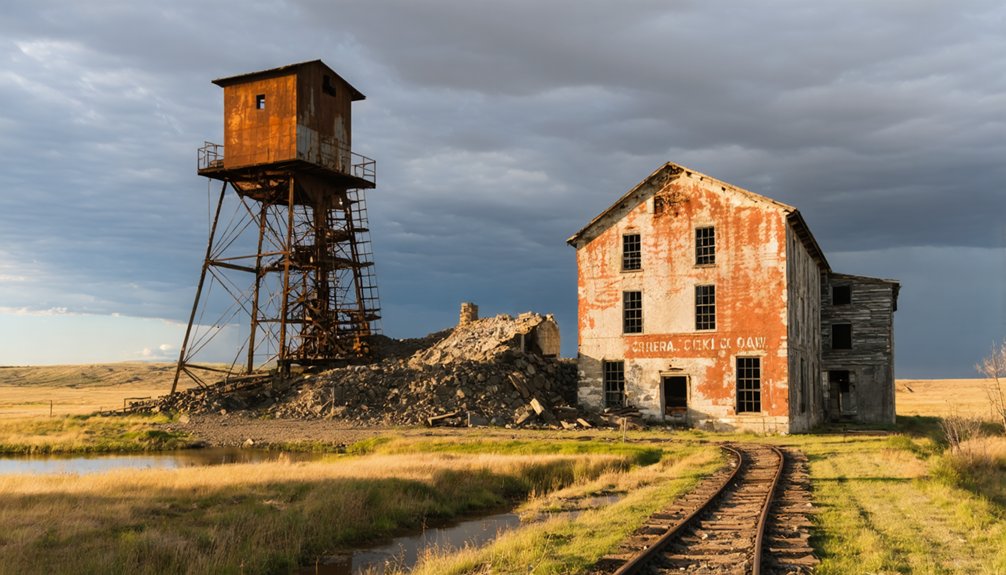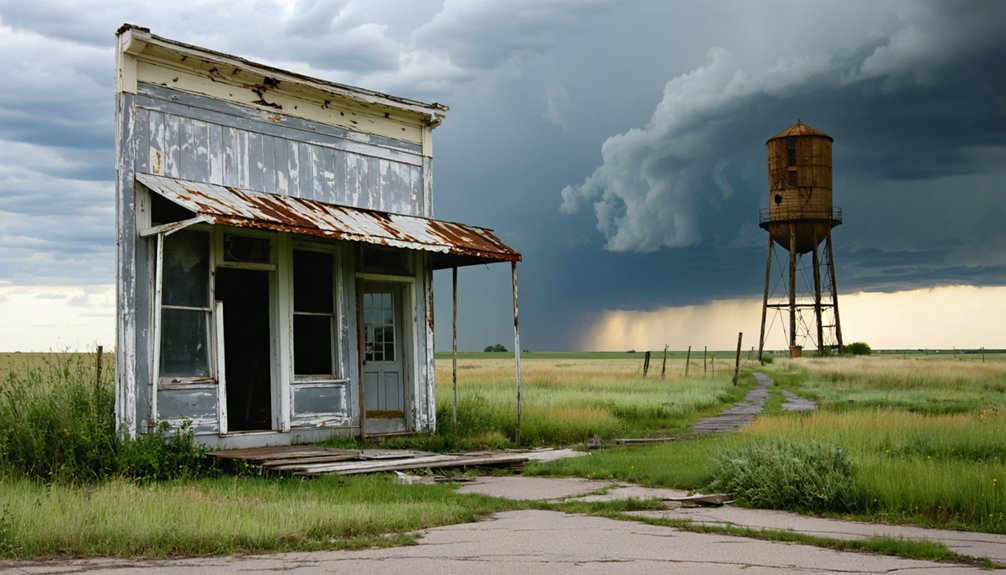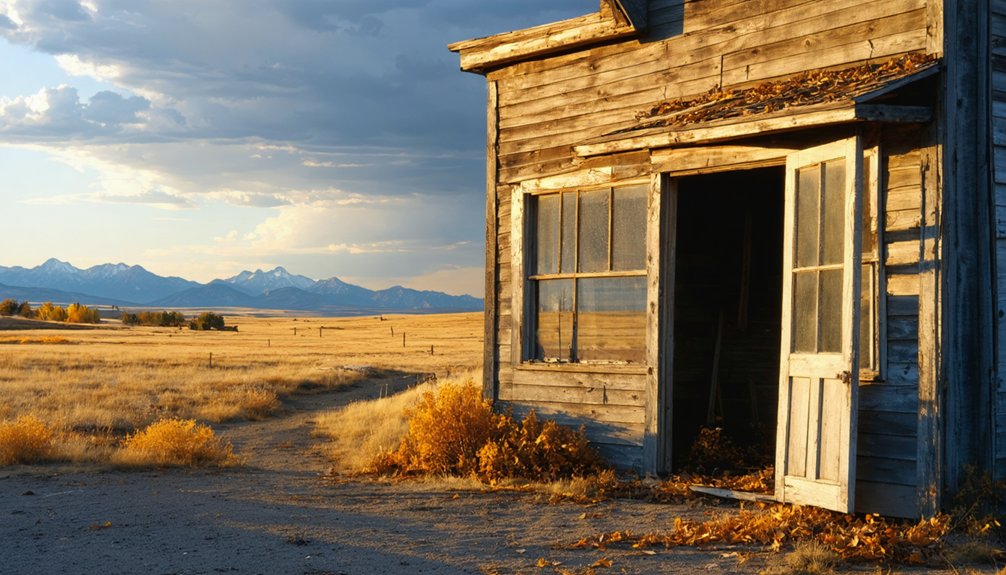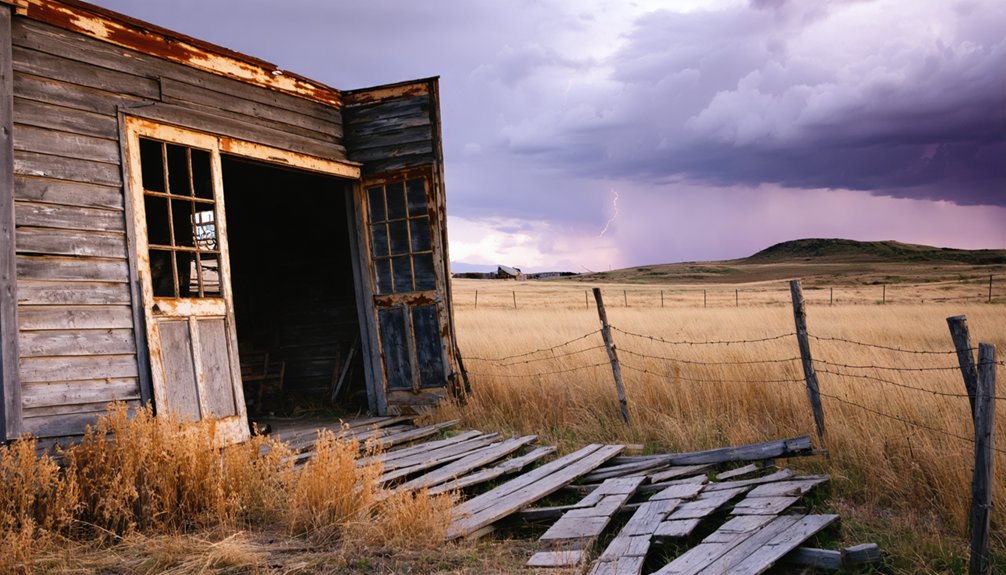You’ll find Squaw Creek ghost town tucked away in South Dakota’s Black Hills, where silver strikes in the 1880s sparked a mining boom that drew thousands. The town bustled with miners’ cabins, saloons, and a massive cyanide plant at the Cleopatra Mine, producing over 76,000 ounces of gold before 1914. Though the rugged terrain and harsh winters eventually drove folks away, the weathered ruins and abandoned mine shafts still whisper tales of its glory days.
Key Takeaways
- Squaw Creek emerged as a South Dakota mining settlement in the early 1880s following silver discoveries near Squaw Creek and Rubicon Gulch.
- The town’s peak mining period yielded 76,000 ounces of gold, with significant production from Cleopatra Mine and Two Johns Mine.
- Difficult terrain and lack of railroad access limited transportation, contributing to the town’s eventual economic isolation and decline.
- The mining community featured saloons, general stores, and boarding houses while supporting a diverse, transient population of miners.
- Today, surviving structures include abandoned mine shafts, ore cart rails, building ruins, and the brick shell of the town hall.
The Rise of a Mining Frontier
While early prospectors found limited success in Spearfish Canyon during the late 1870s, the discovery of silver deposits near Squaw Creek and Rubicon Gulch in the early 1880s transformed this quiet corner of the northern Black Hills into a bustling mining frontier.
You’d have seen the area’s real boom kick off between 1885 and 1891, when silver production peaked before the Panic of 1893 shut things down.
But nature hadn’t finished revealing her treasures. In 1896, prospectors struck gold near Ragged Top Mountain, and despite loose mining regulations of the day, they hauled out over 15,000 ounces by 1899. The area’s gold rush began much like the French Creek discovery that first brought miners to the Black Hills in 1874.
The introduction of cyanide processing around 1900 let miners extract more gold than ever, though environmental concerns eventually led to legal battles, like the shutdown of Reliance Gold Mining Co. in 1908. The district’s total historical production reached 76,000 ounces of gold before mining activity significantly declined after 1914.
Life in the Boomtown Era
Once you’d stepped into Squaw Creek during its heyday, you’d have found yourself in a raw, bustling settlement where life revolved around the daily grind of mining work.
You’d see miners’ cabins and boarding houses dotting the landscape, while saloons and general stores served as hubs for community interactions. Life wasn’t easy – the town lacked proper sanitation, and your wages would’ve fluctuated with the mines’ fortunes. The town’s fate mirrored that of over six hundred ghost towns scattered throughout the Black Hills.
Life in the old mining towns was rough and unpredictable, where a miner’s paycheck rose and fell like the hills themselves.
The transient populations brought a rich mix of cultures and traditions, with immigrants from across the globe seeking their fortune in the Black Hills.
You’d have rubbed shoulders with blacksmiths, merchants, and railroad workers at the local saloon, where gambling and drinks offered escape from the harsh realities of frontier life.
But like many boomtowns, Squaw Creek’s prosperity wouldn’t last forever.
Mining Operations and Technology
As the Black Hills mining boom gathered momentum in 1876, you’d have witnessed the birth of industrial-scale mining at Squaw Creek with the installation of the region’s first quartz mill near Gayville in Deadwood Gulch.
The complex geology included significant fault offsets that complicated extraction efforts throughout the area.
That first mill pulled in $20,000 in gold during its maiden year, and by ’78, you could’ve counted 20 mills with 500 stamps pounding away at the conglomerate ore.
Mining techniques evolved mighty quick when the easy pickings ran dry. The game-changer came with cyanide processing in the late 1800s, letting miners squeeze gold from ore they’d once tossed aside.
But there was a price to pay – environmental challenges cropped up when cyanide leaked into streams and groundwater. Mining companies had to clean up their act, installing leach pads and monitoring systems to keep the poison in check.
Transportation Challenges
You’d have found Squaw Creek’s location among the Black Hills’ rugged terrain mighty challenging to reach, with steep mountain roads that wore down even the toughest freight wagons.
While other mining towns eventually got their railroad connections, Squaw Creek’s isolated position meant it never saw those iron rails coming through.
Without reliable transportation to move heavy mining equipment in or ore out, you can understand why the town’s prospects dimmed as hauling costs ate into any profits those mines might’ve produced.
Like many ghost towns in disrepair, the site eventually succumbed to abandonment as transportation difficulties made mining operations unsustainable.
Difficult Mountain Road Access
While modern travelers face their share of challenging roads, the route to Squaw Creek stands as a demonstration of nature’s defiance of easy passage.
Senator Peter Norbeck, who directed the road’s construction in 1933, wisely advised a maximum speed of 20mph for safe travel.
You’ll find yourself wrangling with three single-lane tunnels, each narrower than the last, where road safety means yielding to oncoming traffic and carefully timing your approach. The tunnels offer breathtaking views of Mount Rushmore when perfectly aligned. Travel efficiency? Don’t count on it – you’re looking at over an hour to cover just 17 miles.
The road’s 314 curves and 14 switchbacks snake through the Black Hills, climbing to elevations over 5,400 feet.
Those famous pigtail bridges spiral under themselves like corkscrews, making even experienced drivers grip their steering wheels tighter.
In winter, you won’t get through at all – the road shuts down completely, leaving Squaw Creek cut off until spring thaw.
Failed Railroad Connections
Despite multiple railroad companies pushing westward across South Dakota in the late 1800s, Squaw Creek never secured the vital rail connection it desperately needed.
Like many early South Dakota settlements, town leaders competed fiercely to attract rail lines through their community. You’d have seen the town’s hopes rise when the Grand Island and Wyoming Central line reached nearby Edgemont in 1889, but those dreams quickly faded. Railroad limitations left Squaw Creek in economic isolation, forcing folks to rely on slow wagon transport for their goods and supplies.
The big railroad mergers of the early 1900s only made things worse. Just like the train workers’ memorial for the Little Fellow near Elrod, abandoned rail plans left lasting marks on Squaw Creek’s landscape.
When companies like the Chicago, Burlington & Quincy started gobbling up smaller lines, they focused on profitable routes between larger towns. Without those vital rail connections, you couldn’t get a depot or grain elevators built, and that spelled doom for Squaw Creek’s chances at real growth.
Notable Mines and Production

You’ll find the Cleopatra Mine‘s impressive 100-ton cyanide plant stood as one of Squaw Creek’s most significant operations, with its mill constructed from lumber taken from the old Hugginson’s Hotel in Carbonate.
The Two Johns Mine carved out an extensive network of underground workings, including 4,000 feet of drifts and tunnels, while the Ragged Top District proved exceptionally rich, yielding ore valued at about $100 per ton during its peak years. The area’s mining success attracted prominent figures like Colonel James Clark, who managed extensive mining operations in the region by 1904.
Between 1896 and 1899, the district’s total gold production reached an impressive $316,000 (roughly 15,285 ounces), though most mining operations had ceased by 1915 due to difficulties in transporting ore to distant smelters.
Major Mining Operations
Throughout the late 19th century, Squaw Creek’s mining district boasted several major operations that shaped the region’s economic landscape.
You’d find the Mascot Mine about 3.5 miles east of Deadwood, where they worked the rich Deadwood Formation deposits starting in 1892.
The Golden Return Mining Company ran the impressive Holy Smoke Camp, using advanced mining techniques on their 100-acre claim in the Black Hills motherlode. They’d built substantial infrastructure, including stamp mills for crushing ore and specialized smelting equipment for handling tough refractory gold.
The Reliance Gold Mining Company worked Annie Creek until 1908, when cyanide pollution shut ’em down.
Over at Gustin, Minerva, and Deadbroke mines, mineral extraction continued until Dakota Gold Corp snatched up the properties in 2014.
Peak Production Years
During the late 1890s to early 1900s, the Squaw Creek district hit its golden stride, with mines dotting the landscape west and south of Ragged Top Mountain.
You’d have seen quite a sight back then – gold discoveries sparking a rush of activity around Squaw Creek and Annie Creek, where fortune seekers employed various mining techniques from basic amalgamation to the more efficient cyanide process.
The biggest producer was the Ragged Top area, which yielded an impressive $316,000 in gold between 1896 and 1899.
All told, the district churned out about 76,000 ounces of gold by 1959, though most came during those peak years.
After 1914, the boom faded into mostly placer operations, marking the end of the district’s glory days.
The mines near Carbonate started with lead and silver but eventually yielded some gold too.
Daily Life and Commerce
Life in Squaw Creek revolved around the demanding rhythms of mining work, with wooden frame buildings housing the town’s hardworking residents.
You’d find folks spending long hours at the Cleopatra Mine‘s cyanide plant or deep in the Two Johns Mine tunnels, earning their daily bread through backbreaking labor. The few community gatherings offered rare breaks from the daily grind, as miners and their families socialized around the camps.
Local merchants kept the town running, stocking mining supplies, food, and essentials at small general stores.
The nearby 100-ton mill processed ore worth about $100 per ton during peak times, though getting it to distant smelters wasn’t easy over the rough terrain.
When mines prospered, you’d see the town bustling with commerce, but when they faltered, businesses quickly shuttered their doors.
The Path to Abandonment

When rich ore veins in the Cleopatra and Two Johns Mines began running dry, you’d see Squaw Creek’s pulse start to fade. The mining town’s economic hardships hit hard, with the cyanide extraction process failing to revive the dying operations.
Mining’s lifeblood flowed from the Cleopatra and Two Johns until the veins ran dry, leaving Squaw Creek gasping its last breaths.
You couldn’t miss the signs of community decline as families packed up and moved on, leaving their homes to weather and time.
- Brutal Black Hills winters and poor roads cut off what was left of commerce
- Railroad service dried up, leaving folks without reliable supply lines
- Mining equipment rusted on hillsides while buildings sagged and crumbled
- No other industries stepped in to fill the void left by mining’s collapse
Without work or ways to make a living, the town’s fate was sealed. Squaw Creek simply couldn’t survive on dreams and memories alone.
Surviving Structures and Ruins
Time stands frozen in Squaw Creek’s scattered ruins, where you’ll find the ghostly remains of what was once a bustling mining community. The few surviving homes stand like weathered sentinels, their roofless frames and crumbling stone walls telling tales of families who once called this place home.
You can trace the town’s layout by following old road beds that wind past commercial ruins, where a general store’s foundation and the skeletal frame of the old bank building still mark Main Street’s path.
Mining remnants dot the landscape, from abandoned shafts to scattered ore cart rails that snake through tailing piles. If you look carefully, you’ll spot the old wellhouse and fence posts that hint at daily life, while the town hall’s brick shell stands as the most prominent reminder of Squaw Creek’s heyday.
Legacy in Black Hills History

Though Squaw Creek’s mines have long since fallen silent, its legacy echoes through Black Hills history as one of the region’s most significant mining districts.
Mining’s pulse may have faded, but Squaw Creek’s story still beats in the heart of Black Hills history.
You’ll find its cultural heritage woven into local stories, from the ambitious cyanide plant at Cleopatra Mine to the rich ore yields that once rivaled the world’s greatest mining camps. The district’s environmental impact remains visible in the scattered remnants of its industrial past.
- The area produced some of the Black Hills’ richest ore, averaging $100 per ton during peak operations
- Railroad grades and an historic bridge stand as evidence to early transportation challenges
- Indigenous significance as part of the sacred Pahá Sápa (Black Hills) adds cultural depth
- Ghost towns like Ragged Top and Preston preserve memories of the boom-and-bust cycle
Frequently Asked Questions
Are There Any Documented Paranormal Activities or Ghost Sightings in Squaw Creek?
Y’all won’t find much proof of real hauntings there. While ghost stories and local legends float around the Black Hills mining towns, there aren’t any credible documented paranormal sightings at Squaw Creek.
What Happened to the Residents After They Left Squaw Creek?
Like tumbleweeds scattered by the wind, you’d find former residents spreading across the Black Hills region, seeking work in larger towns, joining railroad crews, or moving to thriving mining communities.
Can Visitors Legally Explore or Metal Detect in Squaw Creek Today?
You’ll need to verify land ownership and get permissions first. Metal detecting regulations require permits on public lands, and private property needs explicit landowner consent. Follow all visitor guidelines carefully.
Were There Any Major Crimes or Shootouts During Squaw Creek’s Peak?
Like a calm pond in a storm-tossed region, you won’t find records of major crime incidents or historical conflicts here. Historical documents suggest it was surprisingly peaceful compared to wilder Black Hills mining camps.
Did Native Americans Have Any Settlements or Conflicts in the Area?
You’ll find several Native tribes made seasonal camps in that region, particularly Sioux bands. Historical conflicts between tribes and settlers occurred nearby, with documented skirmishes along waterways and trading routes.
References
- https://www.sdpb.org/rural-life-and-history/2023-08-21/some-black-hills-ghost-towns-and-their-origins
- https://www.sdhspress.com/journal/south-dakota-history-2-2/some-black-hills-ghost-towns-and-their-origins/vol-02-no-2-some-black-hills-ghost-towns-and-their-origins.pdf
- https://en.wikipedia.org/wiki/List_of_ghost_towns_in_South_Dakota
- https://core.ac.uk/download/pdf/345016075.pdf
- https://en.wikipedia.org/wiki/Carbonate
- https://www.youtube.com/watch?v=_0WNYsFLSLA
- https://www.blackhillsbadlands.com/blog/post/old-west-legends-mines-ghost-towns-route-reimagined/
- https://thehillsiwander.files.wordpress.com/2016/12/historic-preservation-of-the-northern-black-hills1.pdf
- https://www.powderhouselodge.com/black-hills-attractions/fun-attractions/ghost-towns-of-western-south-dakota/
- https://danr.sd.gov/Environment/MineralsMining/MiningHistory.aspx



